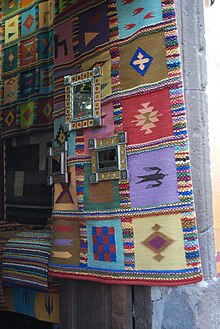Handcrafts and folk art in Guanajuato
Guanajuato handcrafts and folk art are mostly of European origin, although some indigenous work still survives in some communities.
The most notable craft is the making of glazed mayolica pottery, followed by handmade traditional toys of various materials, especially a hard paper mache called cartonería.
The handcrafts of Guanajuato are dominated by products and designs of European origin, such as glazed pottery, serapes, rebozos, tin wares, wrought iron and silver work, although what is made and how they look vary among the various communities of the state.
[2] However, there are some crafts that show influence from the indigenous groups of the state (Otomi, Purhepecha and Chichimeca Jonaz, but they are very local.
[3] Like craftsmen from other areas, they can come from families who have producing a particular craft for generations or be new to the activity because of the popularity of Mexican handcrafts with tourists and collectors.
[3] Many of the wares are sold in major outlets such as the city of Guanajuato and San Miguel de Allende, making them important destinations for handcraft shoppers.
[2] One noted outlet for Guanajuato wares is the La Casa del Diseño en San Miguel de Allende, which has been in the Llamas family since the early 20th century.
In addition to selling wares from Guanajuato and other parts of Mexico, it is also a family workshop, that produced tin and glass items.
[2] The city of Guanajuato makes black ceramics with gold decoration, a style introduced by an artisan named Behrens.
[3] This pottery has its origins in the wares covered in a thick white glaze, brought to Mexico by the Spanish in the 16th century under the same name.
[3][7] It flourished here because of the wealth that the state’s silver mines produced, allowing for the creation of luxury items as well as more common pieces.
The technique, which has not changed much over the past 400 years, has been used to make plates, jars, storage containers, cups, mugs, bottles, flowerpots and more.
Today designs generally include animals, plants and human (from popular culture and history), along with stripes and geometric patterns.
[2][3] While made in various parts of the Bajío region of the state, the two main centers of production and sale are Dolores Hidalgo and the city of Guanajuato.
[7] Most of the traditional designs are present in this work, especially the typical floral decoration, polychrome over a white background, often with reds and greens.
This include items such as plates, jars, cups, flags, teapots and more, generally in colors such as brown, red, blue, green and yellow.
At its height, they were made in towns such as Valle de Santiago, Yurirapundaro, Leon, Uriangato and Moroleón, but today only León makes a small quantity of good quality cotton rebozos.
[7] San Miguel de Allende makes sarapes with modern decorative designs in multiple colors.
One center for its production is San Miguel de Allende, used to make bottles, vases, cups and shot glasses.
The wide variety of fruits that grow in the state, especially in the Bajio, are made into sweet pastes called ate.








